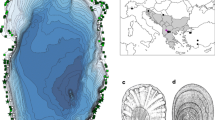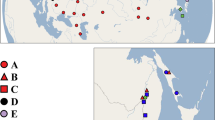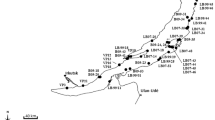Abstract
The morphologically remarkable endemic fauna within ancient lakes has received much attention in the literature. More inconspicuous taxa, however, often lack detailed molecular and morphometrical examination, although their proportion of the endemic fauna of an ancient lake must not be underestimated. Consequently, a better understanding of evolutionary patterns and processes within these lakes requires more knowledge about the often-neglected inconspicuous taxa. In the present study, we focus on the notoriously cryptic pea clam genus Pisidium (Bivalvia: Sphaeriidae). Though the genus is widely distributed, most endemic species are reported only from ancient lakes, including the European ancient sister lake system of Ohrid and Prespa on the Balkan Peninsula. Here we test for the first time hypotheses on the evolution of the endemic pea clams in this European biodiversity hotspot by molecular means. Combining a broad 16S phylogeny (comprising most European pea clam species), network analyses and morphometrical analyses, we found interesting biogeographical patterns and provide evidence for cryptic species in both lakes. Furthermore, we confirmed the proposed sister-species relationship of the endemics P. edlaueri in Lake Ohrid and P. maasseni in Lake Prespa, and we suggest scenarios of the endemic pea clam evolution within both lakes. The patterns of speciation found in the genus Pisidium are compared to patterns in morphologically distinct molluscan groups in lakes Ohrid und Prespa.







Similar content being viewed by others
References
Albrecht, C., R. Schultheiß, T. Kevrekidis, B. Streit & T. Wilke, 2007. Invaders or endemics? Molecular phylogenetics, biogeography and systematics of Dreissena in the Balkans. Freshwater Biology 52: 1525–1536.
Albrecht, C., S. Trajanovski, K. Kuhn, B. Streit & T. Wilke, 2006. Rapid evolution of an ancient lake species flock: freshwater limpets (Gastropoda: Ancylidae) in the Balkan Lake Ohrid. Organisms. Diversity & Evolution 6: 294–307.
Albrecht, C. & T. Wilke, 2008. Ancient Lake Ohrid: biodiversity and evolution. Hydrobiologia. doi:10.1007/s10750-008-9558-y.
Albrecht, C., C. Wolf, P. Glöer & T. Wilke, 2008. Concurrent evolution of ancient sister lakes and sister species: The freshwater gastropod genus Radix in lakes Ohrid and Prespa. Hydrobiologia. doi:10.1007/s10750-008-9555-1.
Angelov, A., 1971. Beitrag zur Kenntnis der Pisidienfauna (Molluska-Sphaeriidae) Mazedoniens. Fragmenta Balcanica 7: 53–55.
Bandelt, H. J., P. Forster & A. Rohl, 1999. Median-joining networks for inferring intraspecific phylogenies. Molecular Biology and Evolution 16: 37–48.
Bößneck, U., 2002. Lebendnachweise von Microcondylaea bonellii (A. Ferussac 1827) und Pisidium tenuilineatum Stelfox 1918 aus Istrien (Kroatien) (Bivalvia: Unionidae et Sphaeriidae). Malakologische Abhandlungen 20: 313–317.
Brooks, J. L., 1950. Speciation in ancient lakes. The Quaterly Review of Biology 25: 131–176.
Cooley, L. R. & D. Ó Foighil, 2000. Phylogenetic analysis of the Sphaeriidae (Mollusca: Bivalvia) based on partial mitochondrial 16S rDNA gene sequences. Invertebrate Biology 119: 299–308.
Dance, S. P. & J. G. J. Kuiper, 2002. B.B. Woodward and the ‘Pisidium affair’. Journal of Conchology 37: 635–650.
Dreher-Mansur, M. C. & C. Meier Brook, 1992. Morphology of Eupera Bourguignat, 1854 and Byssanodonta Orbigny, 1846 with contributions to the phylogenetic systematics of Sphaeriidae and Corbiculidae (Bivalvia, Veneroida). Archiv für Molluskenkunde 128: 1–59.
Dyduch-Falniowska, A., 1989. Remarks on the Sphaeriidae of Greece (Mollusca, Bivalvia). Basteria 53: 15–18.
Ellis, A. E., 1978. British freshwater bivalve Mollusca. The Linnean Society of London, London.
Funk, D. J. & K. E. Omland, 2003. Species-level paraphyly and polyphyly: frequency, causes, and consequences, with insights from animal mitochondrial DNA. Annual Review of Ecology Evolution and Systematics 34: 397–423.
Gambetta, L., 1930. Molluschi terrestri e lacustri d’Albania. Atti della Accademia Scientifica Veneto – Trentino – Istriana. Padova 21: 51–74.
Gorthner, A., 1994. What is an ancient lake? In Martens, K., B. Goddeeris & G. Coulter (eds), Speciation in Ancient Lakes. Archiv für Hydrobiologie, Stuttgart: 97–100
Guralnick, R. P., 2005. Combined molecular and morphological approaches to documenting regional biodiversity and ecological patterns in problematic taxa: a case study in the bivalve group Cyclocalyx (Sphaeriidae, Bivalvia) from western North America. Zoologica Scripta 34: 469–482.
Hall, T. A., 1999. BioEdit: a user-friendly biological sequence alignment editor and analysis program for Windows 95/98/NT. Nucleic Acids Symposium Series 41: 95–98.
Hammer, Ø., D. A. T. Harper & P. D. Ryan, 2001. PAST: Palentological statistics software package for education and data analysis. Palaeontologia Electronica 4: 9.
Hauswald, A.-K., C. Albrecht & T. Wilke, 2008. Testing two contrasting evolutionary patterns in ancient lakes: species flock vs. species scatter in valvatid gastropods of Lake Ohrid Hydrobiologia. doi:10.1007/s10750-008-9556-0.
Holopainen, I. J. & J. G. J. Kuiper, 1982. Notes on the morphometry and anatomy of some Pisidium and Sphaerium species (Bivalvia, Sphaeriidae). Annales Zoologici Fennici 19: 93–107.
Huelsenbeck, J. P. & F. Ronquist, 2001. MrBayes: Bayesian inference of phylogeny. Bioinformatics 17: 754–755.
Illies, J., 1978. Limnofauna Europaea. Gustav Fischer Verlag, Stuttgart, New York.
Jaeckel, S. G., W. Klemm & W. Meise, 1957. Die Land- und Süsswasser-Mollusken der nördlichen Balkanhalbinsel. Abhandlungen und Berichte des Staatliche Museums für Tierkunde. Dresden 23: 141–205.
Jensen, C., J. G. J. Kuiper & K. D. Vorren, 2002. First post-glacial establishment of forest trees: early Holocene vegetation, mollusc settlement and climate dynamics in central Troms, North Norway. Boreas 31: 285–301.
Karaman, M., 1971. Zoogeographische Verhältnisse des Prespa- und Ochridasees. Izdanija 4: 1–21.
Korniushin, A. V., 2004. The bivalve mollusca fauna of ancient lakes in the context of the historical biogeography of the Balkan region. In Griffiths, H. I., B. Krystufek & J. M. Reed (eds), Balkan Biodiversity – Pattern and Process in the European Hotspot. Kluwer Academic Publishers, Dordrecht/Bosten/London: 219–241.
Korniushin, A. V. & M. Glaubrecht, 2002. Phylogenetic analysis based on the morphology of viviparous freshwater clams of the family Sphaeriidae (Mollusca, Bivalvia, Veneroida). Zoologica Scripta 31: 415–459.
Korniushin, A. V. & E. Hackenberg, 2000. Verwendung konchiologischer und anatomischer Merkmale für die Bestimmung mitteleuropäischer Arten der Familie Shaeriidae (Bivalvia), mit neuem Bestimmungsschlüssel und Diagnosen. Malakologische Abhandlungen – Staatliches Museum für Tierkunde Dresden 20: 45–72.
Korniushin, A. V., Z. Krstanovski & G. Kostoski, 2000. Anatomical evidence of close affinity between endemic species of Pisidium (Bivalvia, Sphaeriidae) from some ancient lakes, and the widely distributed taxa. Journal of Zoological Systematics and Evolutionary Research 38: 81–86.
Kuiper, J. G. J., 1960. Die Pisidien des Ohridsees, Mazedonien, nebst Bemerkungen über die Verbreitung der Pisidien in der Balkanhalbinsel und den Donauländern. Beaufortia 7: 219–231.
Kuiper, J. G. J., 1963. Hauptzüge der Verbreitung des Genus Pisidium in Europa. Archiv für Molluskenkunde 92: 247–252.
Kuiper, J. G. J., 1983. The Sphaeriidae of Australia. Basteria 47: 3–52.
Kuiper, J. G. J., 1987. Pisidium maasseni n. sp., a new species from Lake Prespa, Jugoslavia (Bivalvia, Sphaeriidae). Basteria 51: 163–165.
Kumar, S., K. Tamura & M. Nei, 2004. MEGA3: integrated software for molecular evolutionary genetics analysis and sequence alignment. Briefings in Bioinformatics 5: 150–163.
Lee, T. W., 2004. Morphology and phylogenetic relationships of genera of North American Sphaeriidae (Bivalvia, veneroida). American Malacological Bulletin 19: 1–13.
Lee, T. & D. Ó Foighil, 2002. 6-phosphogluconate dehydrogenase (PGD) allele phylogeny is incongruent with a recent origin of polyploidization in some North American Sphaeriidae (Mollusca, Bivalvia). Molecular Phylogenetics and Evolution 25: 112–124.
Lee, T. & D. Ó Foighil, 2003. Phylogenetic structure of the Sphaeriinae, a global clade of freshwater bivalve molluscs, inferred from nuclear (ITS-1) and mitochondrial (16S) ribosomal gene sequences. Zoological Journal of the Linnean Society 137: 245–260.
Maassen, W. J. M., 1980. De zoetwatermollusken van het Ohrid/en Prespameer en hun omgeving. De Kreukel 16: 81–98.
Mackie, G. L., 1978. Larval growth in fingernail and pill clams (Bivalvia: Sphaeriidae). Bulletin of the American Malacological Union: 6–13.
Martens, K., G. Coulter & B. Goddeeris, 1994. Speciation in Ancient Lakes – 40 years after Brooks. Archiv für Hydrobiologie – Advances in Limnology 44: 75–96.
Michel, E., 1994. Why snails radiate – A review of gastropod evolution in long lived lakes, both recent and fossil. In Martens, K., B. Goddeeris & G. Coulter (eds), Speciation in Ancient Lakes. Archiv für Hydrobiologie, Stuttgart: 285–317.
Michel, E., 2004. Vinundu, a new genus of gastropod (Cerithioidea: ‘Thiaridae’) with two species from Lake Tanganyika, East Africa, and its molecular phylogenetic relationships. Journal of Molluscan Studies 70: 1–19.
Miller, M. P., 1997. Tools for population genetic analyses (TFPGA) 1.3: a Windows program for the analysis of allozyme and molecular population genetic data. Northern Arizona University, Flagstaff.
Palumbi, S., A. Martin, S. Romano, W. O. Mcmillian, L. Stice & G. Grabowski, 1991. The simple fool’s guide to PCR. University of Hawaii, Honolulu.
Posada, D. & T. R. Buckley, 2004. Model selection and model averaging in phylogenetics: advantages of Akaike information criterion and Bayesian approaches over likelihood ratio tests. Systematic Biology 53: 793–808.
Posada, D. & K. A. Crandall, 1998. MODELTEST: testing the model of DNA substitution. Bioinformatics 14: 817–818.
Radoman, P., 1983. Hydrobiodea, a Superfamily of Prosobranchia (Gastropoda). Faculty of Science, Department of Biology, Beograd.
Reischütz, P. L. & B. Stummer, 1989. Ein Beitrag zur Molluskenfauna der dessaretischen Seen. Malakologische Abhandlungen 14: 105–109.
Rintelen, T. v. & M. Glaubrecht, 2005. Anatomy of an adaptive radiation: a unique reproductive strategy in the endemic freshwater gastropod Tylomelania (Cerithioidea : Pachychilidae) on Sulawesi, Indonesia and its biogeographical implications. Biological Journal of the Linnean Society 85: 513–542.
Rintelen, T. v. & M. Glaubrecht, 2006. Rapid evolution of sessility in an endemic species flock of the freshwater bivalve Corbicula from ancient lakes on Sulawesi, Indonesia. Biology Letters 2: 73–77.
Rohlf, F. G., 2001. Comparative methods for the analysis of continuous variables: geometric interpretation. Evolution 55: 2143–2160.
Schön, I. & K. Martens, 2004. Adaptive, pre-adaptive and non-adaptive components of radiations in ancient lakes: a review. Organisms, Diversity & Evolution 4: 137–156.
Slugina, Z. V., 2006. Endemic Bivalvia in ancient lakes. Hydrobiologia 568: 213–217.
Slugina, Z. V. & Y. I. Starobogatov, 1999. Guides and keys to identification of fauna and flora of Lake Baikal. Izdalelstvo SO RAN, Novosibirsk.
Stanković, S., 1960. The Balkan Lake Ohrid and Its Living World. Junk, Den Haag.
Thompson, J. D., D. G. Higgins & T. J. Gibson, 1994. CLUSTAL W: improving the sensitivity of progressive multiple sequence alignment through sequence weighting, positions-specific gap penalties and weight matrix choice. Nucleic Acids Research 22: 4673–4680.
Wilke, T., C. Albrecht, V. V. Anistratenko, S. Kosal & M. Z. Yildirim, 2007. Testing biogeographical hypotheses in space and time: faunal relationships of the putative ancient Lake Egirdir in Asia Minor. Journal of Biogeography Journal of Biogeography 34: 1807–1821.
Wilke, T., G. M. Davis, D. Qiu & R. C. Spear, 2006. Extreme mitochondrial sequence diversity in the intermediate schistosomiasis host Oncomelania hupensis robertsoni: another case of ancestral polymorphism? Malacologia 48: 143–157.
Wilke, T. & A. Falniowski, 2001. The genus Adriohydrobia (Hydrobiidae: Gastropoda): polytypic species or polymorphic populations? Journal of Zoological Systematics and Evolutionary Research 39: 227–234.
Wilke, T., M. Pfenninger & G. M. Davis, 2002. Anatomical variation in cryptic mudsnail species: statistical discrimination and evolutionary significance. Proceedings of the Academy of Natural Sciences of Philadelphia 152: 45–66.
Wilson, A. B., M. Glaubrecht & A. Meyer, 2004. Ancient lakes as evolutionary reservoirs: evidence from the thalassoid gastropods of Lake Tanganyika. Proceedings of the Royal Society of London Series B-Biological Sciences 271: 529–536.
Acknowledgments
We are very grateful to the colleagues of the Hydrobiological Institute Ohrid (HBI) for their hospitality, immense support, and for issuing the permits to collect in Lake Ohrid. G. Kostoski, B. Budzakoska, S. Trajanovski and S. Trajanovska provided valuable information and took part in field trips. D. Georgiev is gratefully acknowledged for supporting us with his local expertise and equipment. P. Glöer and V. Pešić as well as V. Fiorentino kindly provided material from Lake Skutari and from Caserta, Italy. S. Nachtigall is gratefully acknowledged for her help in the lab. We are thankful to two anonymous reviewers for their valuable comments that significantly enhanced an earlier version of the manuscript. This work was supported in part by a research grant of The Malacological Society of London to RS. Last not least, the authors would like to thank J. G. J. Kuiper for supporting us with literature and for encouraging our work.
Author information
Authors and Affiliations
Corresponding author
Additional information
Guest editors: T. Wilke, R. Väinölä & F. Riedel
Patterns and Processes of Speciation in Ancient Lakes: Proceedings of the Fourth Symposium on Speciation in Ancient Lakes, Berlin, Germany, September 4–8, 2006
Electronic supplementary material
Below is the link to the electronic supplementary material.
Rights and permissions
About this article
Cite this article
Schultheiß, R., Albrecht, C., Bößneck, U. et al. The neglected side of speciation in ancient lakes: phylogeography of an inconspicuous mollusc taxon in lakes Ohrid and Prespa. Hydrobiologia 615, 141–156 (2008). https://doi.org/10.1007/s10750-008-9553-3
Published:
Issue Date:
DOI: https://doi.org/10.1007/s10750-008-9553-3




